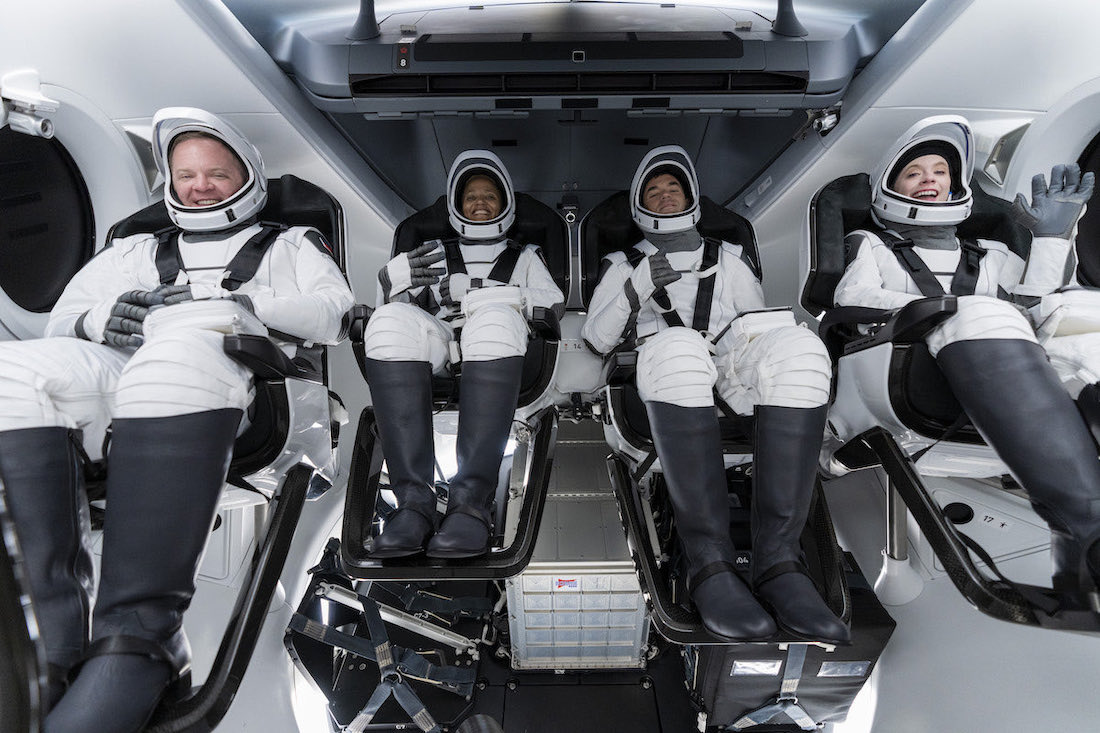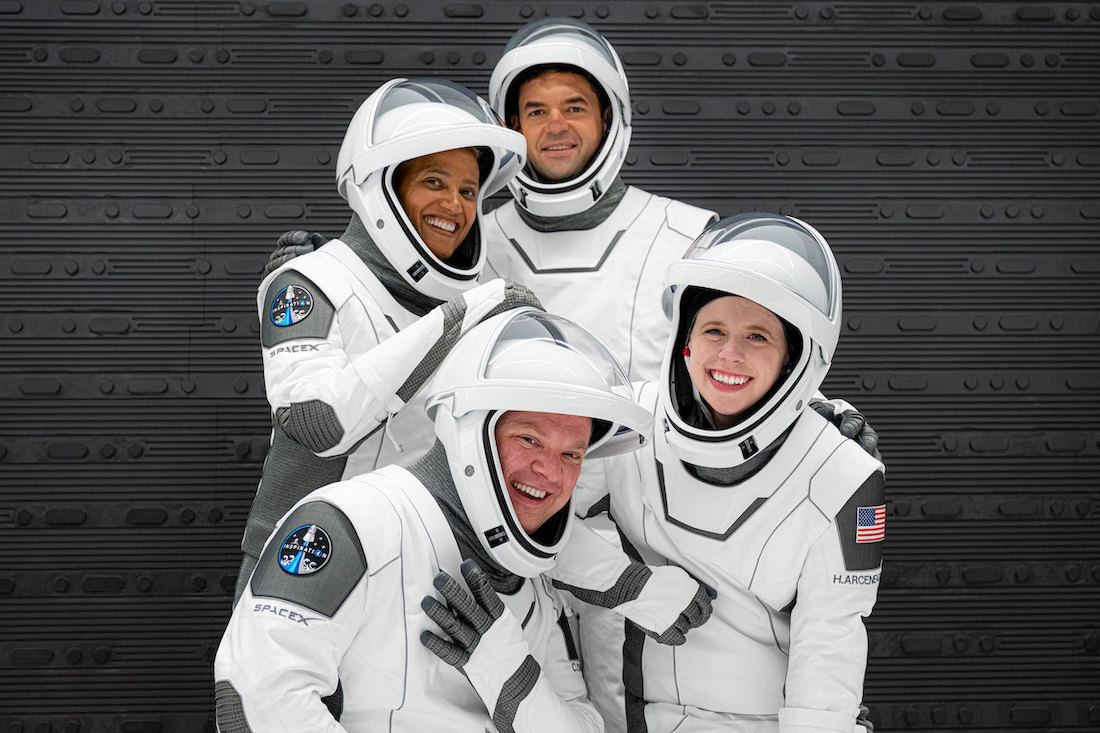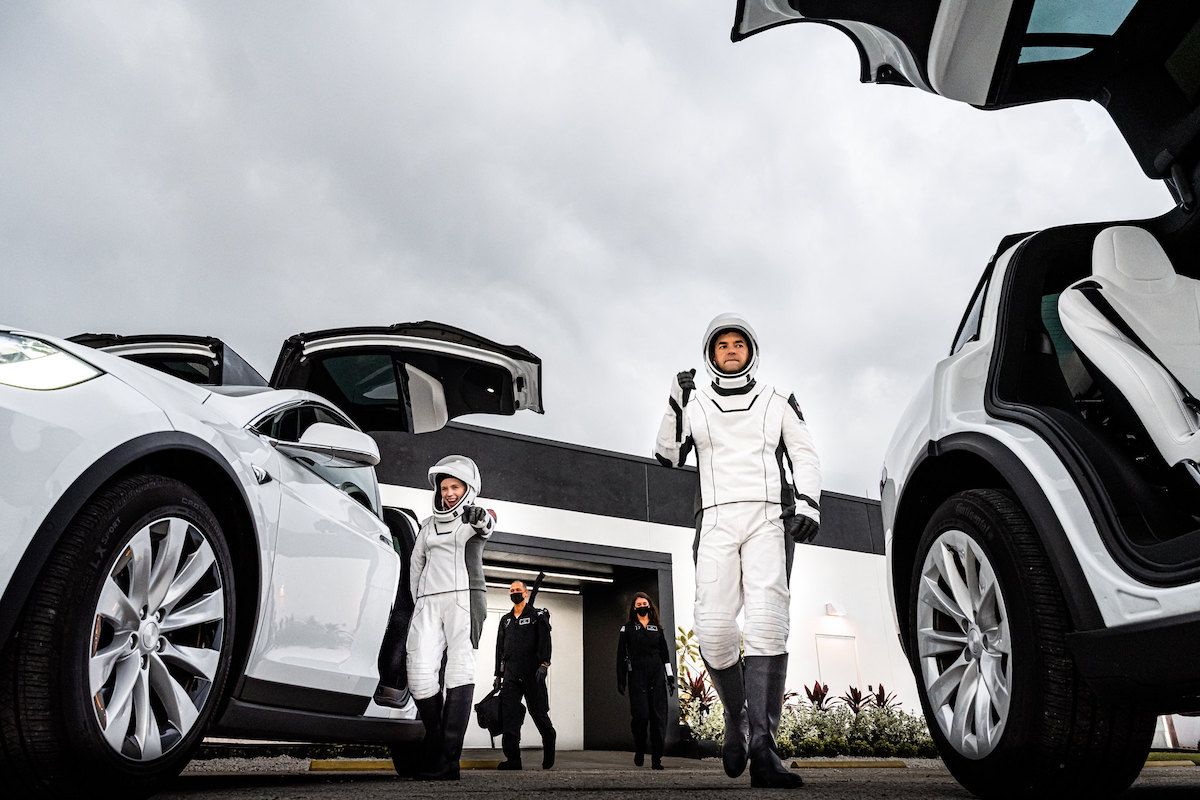
The four civilian fliers who will rocket into orbit this week on the privately-managed Inspiration4 mission took their seats inside a SpaceX crew capsule Sunday night in Florida during a dress rehearsal for launch day.
Hours later, once the crew members cleared the launch pad, SpaceX test-fired the Falcon 9 rocket set to launch the Inspiration4 mission.
The back-to-back milestones came after SpaceX rolled the Falcon 9 rocket and Crew Dragon capsule to launch pad 39A at NASA’s Kennedy Space Center Saturday night. SpaceX erected the 215-foot-tall (65-meter) launcher vertical on the launch pedestal Sunday morning, setting the stage for the crew dress rehearsal later in the day.
The Inspiration4 mission is set to become the first human spaceflight to reach orbit with a crew comprised entirely of private citizens. Every crew to fly in Earth orbit to date has been led by a government-employed astronaut.
In July, Virgin Galactic and Blue Origin — founded by billionaires Richard Branson and Jeff Bezos — launched all-private crews into space on their own commercial spaceships. But those suborbital missions only reached the edge of space, giving the passengers a few minutes of microgravity and offering brief views of Earth from an altitude of more than 50 miles (80 kilometers).
Commanded by Jared Isaacman, a billionaire who paid SpaceX for the three-day, four-seat flight, the Inspiration4 mission is the centerpiece of a charity-focused project designed, in part, to raise $200 million for St. Jude Children’s Research Hospital, a nonprofit institution devoted to treating children with cancer and other pediatric diseases.
Isaacman is a civilian pilot with experience flying high-performance fighter jets. But SpaceX’s Crew Dragon capsule is fully automated, with ground teams at mission control also able to send commands to the spacecraft.
Crew members inside the ship’s pressurized compartment, about the size of a large SUV, can intervene to manually command a de-orbit burn, parachute deployment, or take other actions if something goes wrong.
Isaacman, 38, will be joined on the mission by Sian Proctor, 51, a private pilot and science educator with a master’s degree in geology, Hayley Arceneaux, a 29-year-old physician assistant at St. Jude, and Chris Sembroski, a 42-year-old data engineer from the Seattle area.
Proctor and Sembroski got their seats through a competition and a lottery. Arceneaux, a survivor of childhood cancer, was named to the crew to represent “hope.”
While Isaacman hasn’t disclosed exactly how much he paid SpaceX for the Inspiration4 mission, each Crew Dragon seat sells for more than $50 million, according to a report by NASA’s inspector general.
The Inspiration4 crew members have trained in a simulator at SpaceX’s headquarters in Hawthorne, California, flown in fighter jets, and taken a flight on a zero-gravity training aircraft to provide a taste of what they will experience in orbit.
They arrived at Kennedy Space Center last week for the final week of launch preparations.
On Sunday evening, Isaacman and his crewmates participated in a “dry dress rehearsal” with SpaceX, practicing each step they will take on launch day.
The four crew members departed from SpaceX’s Hangar X facility at Kennedy Space Center around 6 p.m. EDT (2200 GMT) and rode in Tesla Model X automobiles to pad 39A, where SpaceX has outfitted a room where private crews like Inspiration4 will put on their spacesuits.
The Inspiration4 crew donned their flight suits, completed air pressure integrity checks, then completed the journey to the launch mount, where they rode an elevator up the pad tower. Once at the 265-foot level, Isaacman and his crewmates wawlkled across the access arm leading to the Crew Dragon hatch.
SpaceX personnel assisted the crew in boarding the capsule and taking their seats, then the private astronauts exited the spaceship to complete the dress rehearsal around 10 p.m. EDT.
With the crew members safely out of the launch pad danger zone, SpaceX next loaded kerosene and liquid oxygen propellants into the two-stage rocket for a test-firing of the Falcon 9’s Merlin main engines.
After a simulated countdown, the rocket’s first stage engines ignited for several seconds at 2:30 a.m. EDT (0630 GMT) Monday, putting out 1.7 million pounds of thrust while hold-down clamps kept the Falcon 9 firmly on the ground.
SpaceX drained propellants from the rocket after the static fire, while engineers looked over data to verify all systems are ready for launch.
Assuming everything looks good, SpaceX is expected to give a “go” for launch during a final readiness review.

SpaceX will launch the Inspiration4 crew members to an altitude of roughly 357 miles (575 kilometers), above the altitude of the International Space Station. That’s higher than anyone has flown in more than a decade, since the space shuttle serviced the Hubble Space Telescope.
The Crew Dragon capsule will circle Earth dozens of times before re-entering the atmosphere for a parachute-assisted splashdown off the coast of Florida three days after liftoff.
It will be just the fourth flight of a Crew Dragon capsule with people on-board, following three launches that carried NASA astronauts to the space station. The capsule assigned to the Inspiration4 mission is Crew Dragon Resilience, which completed its first flight to space earlier this year.
The Inspiration4 mission will not dock with the station, but will orbit solo. SpaceX replaced the docking port on the Crew Dragon capsule with a glass dome designed to give the crew members panoramic views of Earth and space as the ship speeds around the planet at more than 17,000 mph.
A launch weather forecast issued by the U.S. Space Force’s 45th Weather Squadron Monday predicts an 80% chance of favorable conditions at the Kennedy Space Center for liftoff of the Inspiration4 mission Wednesday night.
The launch window opens at 8:02 p.m. EDT Wednesday (0002 GMT Thursday) and closes at 1:13 a.m. EDT (0513 GMT). SpaceX has four instantaneous launch opportunities available during the window, each separated by about 103 minutes, the time it takes for teams to recondition the Falcon 9’s densified propellants for a fresh launch attempt.

There is a moderate risk that onshore winds could be out of limits, forecasters said Monday. Officials will watch this parameter to ensure winds wouldn’t blow the Crew Dragon capsule back onto land in the event of an emergency escape maneuver using the craft’s powerful SuperDraco thrusters before or during liftoff.
Managers will also monitor wind and sea conditions in the Atlantic Ocean along the Falcon 9 rocket’s flight corridor northeast from Kennedy Space Center. The rocket will fly roughly parallel to the U.S. East Coast to deliver the Crew Dragon capsule to an orbit inclined 51.6 degrees to the equator.
The spaceship could splash down along the flight path if a rocket failure triggers an in-flight abort, and one of SpaceX’s drone ships has deployed to a downrange recovery zone for landing of the Falcon 9’s reusable first stage booster.
Email the author.
Follow Stephen Clark on Twitter: @StephenClark1.
